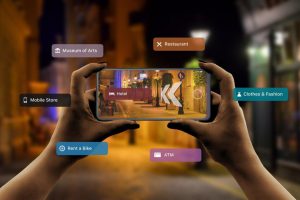In today’s hyper-competitive landscape, businesses must meet ever-rising customer expectations to stay ahead. With consumers demanding personalized experiences and seamless omnichannel engagement, brands need innovative solutions to bridge the gap between customer needs and business capabilities. Conversational AI has emerged as a pivotal technology in this regard, offering immense potential to transform customer interactions.

A recent study by Juniper Research predicts that the total number of annual consumer interactions with AI-powered voice assistants will exceed 1 trillion by 2023. Propelled by advancements in natural language processing (NLP) and neural networks, these assistants are permeating everyday life through applications like virtual assistants, chatbots, and smartphone apps.
In this article, we explore how brands can harness conversational AI and machine learning to deliver personalized, context-aware experiences within their mobile applications.
The Need for Personalization in Mobile Apps
In an experience-driven economy, customers expect mobile apps to understand their preferences and provide tailored functionality. Generic experiences no longer suffice. Users want apps that adapt to their individual needs and usage patterns.
Consider ride-hailing platforms like Uber. Beyond basic pickup and drop-off, customers want to customize experiences based on vehicle types, service tiers, preferred drivers, pickup locations, and more.
For such personalization, apps need to intelligently process signals from user behavior and contexts. This is where AI and machine learning enter the picture.
The Role of AI and Machine Learning
AI and ML algorithms help apps interpret the wealth of unstructured data from customer interactions and environments. By identifying patterns and mapping correlations, these algorithms personalize experiences in two key ways:
1. Predictive Personalization
Apps can forecast user needs and preferences by analyzing historical interactions and behavioral data. For instance, an e-commerce app can suggest products that align with a customer’s past purchases and search trends.
Similarly, streaming platforms like Netflix apply collaborative filtering algorithms to understand similarities between users and content. This allows them to deliver personalized recommendations that connect people with relevant titles.
2. Contextual Personalization
Beyond past interactions, apps can also contextualize experiences using signals like time, location, activity, and environment. Music apps like Spotify adapt playlists based on contexts like workout sessions. Navigation apps like Google Maps update recommendations responding to real-time traffic conditions.
In essence, predictive and contextual personalization helps mobile apps become intelligent companions that evolve with user needs. But how can developers enable this capability?
Integrating AI in Mobile App Development
While building AI-enabled personalization from scratch is complex, developers can take advantage of conversational AI solutions like chatbots and virtual assistants. By seamlessly integrating these solutions with mobile apps, brands can accelerate their personalization initiatives.
1. Intuitive Interfaces
Conversational interfaces powered by NLP facilitate intuitive user interactions using natural language. Users can engage in dialogue with apps, issuing commands, asking questions and driving self-service experiences. This boosts convenience, especially for activities like purchases and customer support.
Consider Domino’s mobile app. It lets users reorder favorite pizzas or track orders through conversational interactions with the Dom chatbot. The user-friendly interface drives higher engagement across contexts.
2. Contextual Dialogue
Unlike rigid commands, conversational systems can adapt responses based on contextual signals. They analyze unstructured data like user utterances, environments and external databases to sustain coherent, meaningful dialogues. Over time, conversations become highly personalized.
For instance, geographical and vehicular context can refine interactions with automotive virtual assistants. Questions about nearest rest stops or parking spots elicit different answers depending on location and car models. This context-aware capability enhances relevance.
3. Seamless Workflows
Conversational interfaces enable seamless linkage between different workflows within mobile apps. Users can initiate complex workflows with a single utterance. For instance, asking a travel app to “Book a Maui hotel with ocean view for next month” triggers a cascade of steps from destination search to date selection, filtering, payment processing and confirmation. Streamlined workflows boost convenience.
Besides ease of use, conversational AI also enriches app functionality. Developers can integrate capabilities like multilingual support, fraud detection and data analytics relatively easily by tapping into AI cloud services. With the right strategy, conversational AI can become an invaluable asset in mobile app innovation.
Real-World Examples of Conversational AI in Mobile Apps
Many leading brands have already incorporated conversational interfaces within their mobile apps to drive personalization at scale. Here are a few prominent examples:
- Sephora – The beauty retailer’s mobile app leverages AI to provide a personalized skin diagnosis based on uploaded images and conversational questions. It then suggests suitable products aligned with individual skincare needs.
- Nike – Nike’s mobile personal trainer app, Nike Run Club, uses a conversational coach to motivate and guide athletes during running sessions based on dynamic factors like performance, routes and heart rate.
- Uber – Uber’s mobile app integrates a conversational interface to simplify processes like pickup, drop-off and payments without needing to touch the screen, enhancing convenience through voice-powered personalization.
- Capital One – Capital One mobile banking app customers can use the conversational Eno interface to execute transactions, track spending, manage credit lines and redeem rewards through natural voice and text conversations.
These examples highlight the transformative impact of infusing machine learning-driven conversational interfaces within mobile applications to raise the bar on personalization.
Key Takeaways
- Conversational AI and machine learning help mobile apps deliver predictive and contextual personalization aligned with user needs and environments.
- Natural language interfaces facilitate intuitive engagement through conversations.
- Contextual signals get incorporated into dialogues to enhance relevance over time.
- Conversational capabilities augment and connect app workflows, boosting convenience.
- Leading brands are already reaping big returns on investment from conversational AI adoption. With large language models, cloud-based development platforms and automated testing tools advancing conversational AI, integration barriers are disappearing. The possibilities for innovation are limitless. Brands that leverage conversational interfaces to drive personalization can gain a sustained competitive edge.
About Us
We are QuickStartApps, a leading mobile app development company specialized in leveraging emerging technologies like AI, machine learning and IoT to build smart, scalable mobile solutions. Get in touch to explore how we can help you deliver next-gen personalized mobile experiences.




Pingback: Elevating Gaming Narratives: The Impact of AI-Driven Dynamic Storytelling - Quick Startapps
Pingback: The Rise of AI-Powered Mobile Esports: A New Era in Gaming - Quick Startapps